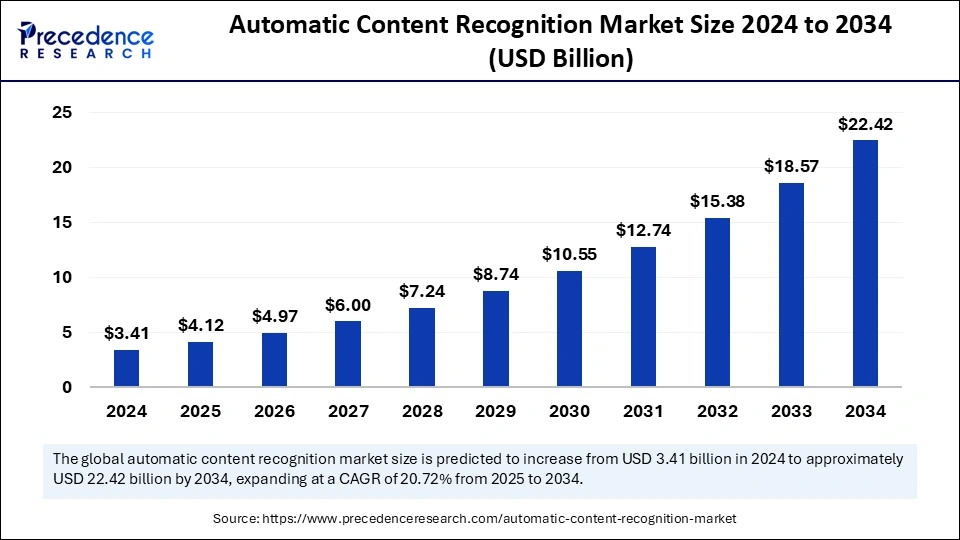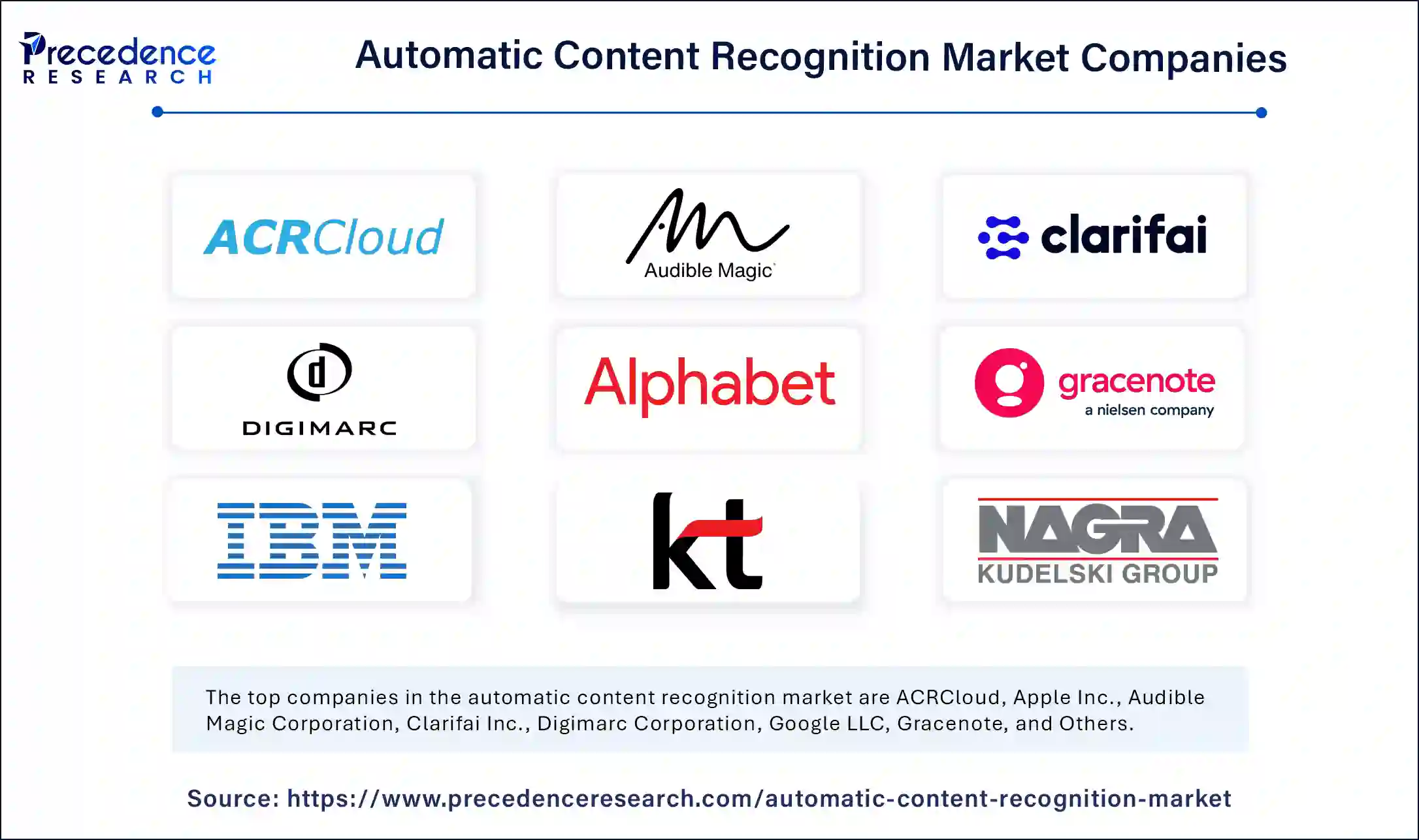The global automatic content recognition market size was valued at USD 3.41 billion in 2024 and is predicted to cross around USD 22.42 billion by 2034, growing at a CAGR of 20.72% from 2025 to 2034.

Get a Free Sample Copy of the Report@ https://www.precedenceresearch.com/sample/5758
Key Insights
-
North America maintained its leadership position with a 35% market share in 2024.
-
Asia Pacific is set to experience robust growth with a CAGR of 22.6% over the forecast period.
-
Software solutions dominated the component segment with a 75% market share in 2024.
-
Services are anticipated to expand at a rapid CAGR of 21.8% in the coming years.
-
Audio-based content recognition held the largest share in 2024.
-
The video content recognition segment is projected to grow at the fastest rate.
-
Smart TVs remained the top platform for automatic content recognition in 2024.
-
The OTT segment is forecasted to see strong expansion in the foreseeable future.
-
The audio & video fingerprinting technology segment led the market in 2024.
-
Optical character recognition (OCR) is set to witness the highest growth from 2025 to 2034.
-
Media & entertainment emerged as the largest industry vertical in 2024.
-
The healthcare industry is poised for the fastest growth in the coming years.
-
Audience measurement applications held the largest market share in 2024.
-
Ad-tracking applications are projected to grow at a rapid pace during the forecast period.
What is Automatic Content Recognition (ACR)?
Automatic Content Recognition (ACR) is a technology that enables devices to recognize audio, video, or images automatically without requiring user input. ACR is commonly used in smart TVs, mobile apps, and streaming services to identify media content and provide relevant information, recommendations, or interactive experiences. By analyzing digital signals, ACR can detect specific content, track viewership patterns, and synchronize multimedia across devices in real time.
How ACR Works
ACR works by using advanced algorithms such as fingerprinting, watermarking, and optical character recognition (OCR) to analyze and identify media content. These technologies compare audio or video snippets with a database to detect matches. When content is recognized, the system can deliver contextual data, such as metadata, additional content, or targeted advertisements, enhancing user engagement and improving content monetization.
Applications of ACR
-
Media & Entertainment: ACR helps streaming platforms and broadcasters analyze audience engagement, personalize content recommendations, and track viewership metrics.
-
Advertising & Marketing: Brands use ACR to measure ad effectiveness, track consumer interactions, and deliver targeted advertising based on real-time content recognition.
-
Smart TVs & OTT Platforms: ACR enables interactive TV experiences, second-screen applications, and personalized streaming suggestions.
-
Healthcare & Education: In healthcare, ACR aids in analyzing medical imaging and transcribing audio data, while in education, it enhances remote learning through speech recognition and automated captioning.
Role of AI in the Automatic Content Recognition (ACR) Market
AI is revolutionizing the automatic content recognition (ACR) market by enhancing content identification, personalization, and real-time analytics. AI-driven ACR systems efficiently analyze and categorize digital media, enabling seamless content recognition across various platforms. Streaming services and social media platforms leverage AI to offer personalized recommendations based on user behavior, ensuring higher engagement and improved viewer experiences.
Advertisers also benefit as AI-powered ACR helps track audience interaction with ads, optimizing targeted marketing strategies for better conversion rates. Additionally, AI strengthens security by detecting copyright infringements and unauthorized content distribution, helping media companies protect their intellectual property and prevent revenue loss.
Beyond personalization and security, AI enhances the accessibility and functionality of ACR systems. AI-powered speech-to-text transcription, real-time captions, and image recognition improve content accessibility for users with disabilities. Moreover, AI-driven ACR enables second-screen experiences and seamless content synchronization across smart TVs, mobile devices, and OTT platforms. In media analytics, AI helps broadcasters measure audience engagement, refine content strategies, and optimize media distribution.
With advancements in deep learning, AI continues to evolve, making ACR systems more intelligent, efficient, and capable of transforming the way digital content is recognized, tracked, and consumed.
Market Overview
The ACR market is revolutionizing the way digital content is consumed, analyzed, and monetized. By enabling real-time identification of media content, ACR technology is helping businesses enhance user engagement, improve content discovery, and optimize advertising revenues. With the increasing shift towards AI-driven automation and smart media consumption, ACR is becoming an essential tool for businesses looking to leverage audience data for targeted marketing and content personalization.
Growth Factors of the Automatic Content Recognition (ACR) Market
-
Rising Demand for Personalized Content
The increasing preference for customized and interactive content is driving the adoption of ACR technology. Streaming platforms, smart TVs, and mobile applications use ACR to analyze user behavior and deliver tailored recommendations, enhancing viewer engagement. -
Expansion of Smart TVs and Connected Devices
The growing adoption of smart TVs, OTT platforms, and IoT-enabled devices is fueling the ACR market. As more households integrate smart entertainment systems, ACR plays a vital role in synchronizing content across devices and enabling seamless user experiences. -
Growing Digital Advertising and Targeted Marketing
ACR is widely used in the advertising industry for real-time audience measurement, ad tracking, and targeted marketing. Brands leverage ACR technology to analyze consumer engagement with commercials, optimize ad placement, and improve return on investment (ROI). -
Advancements in Artificial Intelligence and Machine Learning
AI-driven ACR solutions enhance content recognition accuracy, automate media analysis, and improve real-time content identification. The integration of machine learning algorithms allows ACR to detect audio and video content more efficiently, further accelerating its adoption. -
Increasing Popularity of Second-Screen Applications
The rise of second-screen experiences, where users engage with additional content on smartphones or tablets while watching TV, is boosting the demand for ACR. This technology enables seamless synchronization between devices, enhancing interactive engagement and multi-platform content consumption. -
Growing Applications in Healthcare and Education
Beyond entertainment and advertising, ACR is finding applications in sectors like healthcare and education. In healthcare, ACR is used for medical imaging analysis, while in education, it supports automated transcription, captioning, and real-time content accessibility. -
Adoption of Real-Time Data Analytics
Businesses and media companies are increasingly relying on real-time data analytics to understand consumer behavior and optimize content strategies. ACR provides valuable insights by tracking viewing habits, media consumption patterns, and ad effectiveness, contributing to its market growth. -
Government Regulations and Anti-Piracy Measures
Governments and media companies are leveraging ACR technology to combat content piracy and ensure copyright protection. ACR helps in detecting unauthorized content distribution, protecting intellectual property, and enforcing compliance with digital rights management (DRM) policies.
Market Scope
| Report Coverage | Details |
| Market Size by 2034 | USD 22.42 Billion |
| Market Size in 2025 | USD 4.12 Billion |
| Market Size in 2024 | USD 3.41 Billion |
| Market Growth Rate from 2025 to 2034 | CAGR of 20.72% |
| Dominated Region | North America |
| Fastest Growing Market | Asia Pacific |
| Base Year | 2024 |
| Forecast Period | 2025 to 2034 |
| Segments Covered | Component, Content, Platform, Technology, Industry Vertical , Application, and Regions |
| Regions Covered | North America, Europe, Asia-Pacific, Latin America and Middle East & Africa |
Market Dynamics
Market Drivers
Key market drivers include the rise of AI and machine learning in media analytics, the increasing demand for real-time audience measurement, and the expansion of digital streaming services. As media companies seek to gain deeper insights into viewer behavior, ACR technology is being widely adopted to enhance content recommendations and optimize advertising strategies. The shift toward second-screen experiences and cross-device content consumption is also fueling market demand.
Market Opportunities
Significant growth opportunities exist in the integration of ACR with augmented reality (AR) and virtual reality (VR) experiences. ACR’s role in enabling interactive content engagement for gaming, e-learning, and virtual events presents a new dimension of growth. Additionally, the expansion of programmatic advertising and AI-driven marketing solutions is driving investment in ACR technology for more effective audience targeting.
Market Challenges
Challenges in the ACR market include concerns over consumer data privacy, regulatory constraints, and competition among content recognition technologies. The need for seamless interoperability between ACR-enabled devices and content providers remains a challenge, requiring further advancements in AI algorithms and data synchronization methods. Additionally, resistance from traditional advertising agencies toward automated content recognition solutions could slow adoption rates in certain regions.
Regional Insights
The North American market continues to lead in ACR adoption, driven by advanced digital advertising strategies, smart device penetration, and media investments. Asia Pacific is expected to experience rapid expansion, fueled by increasing digitalization, internet penetration, and government support for AI innovations. Europe remains a strong player in the market, with growing interest in audience measurement tools and AI-powered content monetization strategies.
Recent Developments
- In December 2022, VIZIO announced a census-representative panel built using automatic content recognition (ACR) data from Inscape, VIZIO’s ACR data subsidiary.
- In September 2022, LG Electronics (LG) announced a rollout of LG Ads Solutions proprietary automatic content recognition (ACR) technology across LG TVs.
Automatic Content Recognition Market Companies

- ACRCloud
- Apple Inc.
- Audible Magic Corporation
- Clarifai Inc.
- Digimarc Corporation
- Google LLC (Alphabet Inc.)
- Gracenote
- IBM Corporation
- KT Corporation
- Kudelski Group
- Microsoft Corporation
- Nuance Communications Inc.
Segments Covered in the Report
By Component
- Software
- Services
By Content
- Audio
- Video
- Text
- Image
By Platform
- Smart TVs
- Linear TVs
- Over-The-Top (OTT)
- Others
By Technology
- Audio & Video Watermarking
- Audio & Video Fingerprinting
- Speech Recognition
- Optical Character Recognition (OCR)
- Others
By Industry Vertical
- Media & Entertainment
- IT & Telecommunication
- Automotive
- Retail & E-commerce
- IT & Telecommunication Electronics
- Government & Defense
- Others
By Application
- Audience Measurement
- Content Enhancement
- Broadcast Monitoring
- Content Filtering
- Ad-tracking
- Others
By Region
- North America
- Europe
- Asia Pacific
- Middle East & Africa
- Latin America
Also Read: B2B Continuing Education Market
Ready for more? Dive into the full experience on our website@ https://www.precedenceresearch.com/
